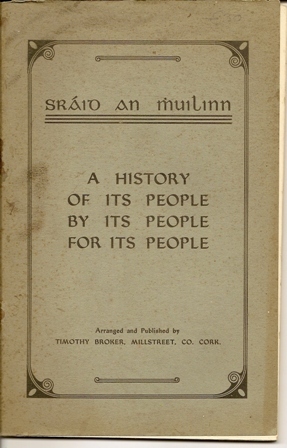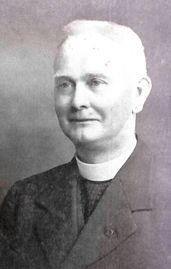
Sráid an ṁuilinn [Millstreet, County Cork, Ireland] A History of its people by its people for its people. Part 1. Arranged and published by Timothy Broker, Millstreet, Co. Cork., no date, c.1930s.
Millstreet museum currently has a copy of this publication, as do some private residences locally, and there is a copy in the National Library of Ireland
Timothy Broker is a pseudonym, as it was actually written by Fr. William Ferris, a curate in Millstreet in the 1930s, who had a previous publication blocked by the Bishop of Kerry, so he used the pseudonym to get around this. He devoted himself to recording oral history and folklore in danger of going to the grave; as he put it, “Each time the east wind blows, it takes an old seanachaí with it”.
============

Fr. William Ferris was in Millstreet Parish from 1934-1935.
Apparently it was compiled from information gathered at Station Masses, It is a comprehensive list of the antiquities of the area. [2: Origin and Development of the Parish of Millstreet]
The book was published in 1937 (reprinted 1972 and 1982).
He is not to be confused with Fr. Owen McFineen Ferris who was Parish Priest of Drishane around 1700, and whose church was the old one in Ballydaly, about 250m south of Croohig’s cross. [2]
Read more on Fr. William Ferris in this other article: Fr Ferris Parish Histories (2018)
============
The book was reviewed in 1837 by the Cork Historical and Archaelogical Society. See the review here:
Sráid an Mhuilinn. A History of its People, by its People, for its People. Part I. Arranged and published by Timothy Broker, Millstreet, Co. Cork. Price 2s. net.
This booklet (of 56 pages) is, perhaps, a sign of the times. Its compilation is a sign that one man is interested in the history of his locality ; its publication is an indication of the author’s optimistic outlook that many others are sufficiently interested to be readers of the information he has brought together. We sincerely hope Mr. Broker’s optimism is justified and we wish the booklet every success. The sub-title is misleading. The booklet is not a “history ” of the parish ; it is, what is much more valuable, a survey of the archaeological remains in it : fulachta fiadh, megaliths, standing stones, holy wells, forts and souterrains, as well as some other finds and miscellaneous monuments. A book of this kind must not be judged by the same standards as one by a recognised authority on history or archaeology. Its faults are obvious, but it is, nevertheless, a very useful compilation and of value not only to those who live in the Millstreet area but also to those caring for Irish archaeology, wherever they live. The specialist will find in it some items of interest, e.g., the note on the finding of a bronze axe in a fulacht fiadh at Baile na Tona (p.11). It is further of considerable value to have as it were a statistical summary of all the remains of antiquity in a particular area, especially since so many of the remains are not so outstanding as to be noticed in archaeological literature generally and belong to the less ” respectable ” side of archaeology. The townland names are given in Irish. This is excellent, but, when unaccompanied by the Ordnance Survey Map form, leads to one inconvenience. The official map spelling of the name may be quite at variance with local pronunciation and philological accuracy, but it is the only one which the worker unacquainted with the district can use in order to find the name in the townland census or on the map. We therefore feel that the official names might have been inserted either in brackets under the Irish forms or as an addendum. Booklets of this kind are frequent in France. The author may be the local teacher, abbe or local official, and they vary much in excellence, but almost all are of use because they are local in their treatment. It is to be hoped that we shall have more of such work in Ireland. We conclude this review by a quotation from a passage (refreshing, whether we agree with it or not) in Mr. Broker’s Foreword : ” I like parish history. It is the best antidote for, as it is the antithesis of the daily newspaper, the latter focusing all space on one small point of time and making, in my opinion, for ignorance and savagery, and the former focusing all time on one small point of space and making for knowledge and civilisation.”

Correction: Sráid an Mhuilinn
Yes, that’s how it is spells these days, but that’s it’s spelled without the ‘h’ on the front of the book!
I’m not going to argue with a generation the most of whom could speak Irish fluently. We have some of old books as Gaeilge, and one of the things I always noticed was that the spelling was often a little different to that which we were taught in school. Maybe it’s a mistake, or maybe it’s just how languages evolve.
Hi Michael, nothing to do with language change, but change in orthography. The dot above a consonant indicated lenition in old Gaelic script. In the Roman script a ‘h’ is placed after the lenited consonant. So, dot in old script, +h in modern script. Regards, Colm.
what was i thinking? I always use the old Irish agus ‘⁊’ in my handwriting, and should have noticed the old gaelic script. I think I just hadn’t seen the dot. thanks for explaining
You’re welcome 🙂
Any plans to scan it and make it available online, or are there the usual copyright issues?
It’s an interesting idea. i’d love to have a look at it myself. we had been considering scanning and publishing some other old items.
In Ireland, copyright generally lasts until the authors death + 70 years (from the Copyright Association of Ireland)
Is there a way to buy a copy of this? I recently found out that my great great parents’ marriage certificate is recorded in Millstreet although they were married in Knocknagree. Sadly, I left Ireland yesterday without finding any more information on my ancestors but I’m anxious to learn more about the area and my family. I know relatives names and I have a letter written from my great great grandmother in the year 1935 from Mount Cairn (not sure where that is exactly).
Perhaps this has been scanned sometime since the last comments were recorded or has been released in a new edition which I could buy?
Thanks for any information. It seems that information about Knocknagree is not available on the online ancestory sites so I’m hopeful that I can learn more about Millstreet and why it is mentioned on their marriage cert.